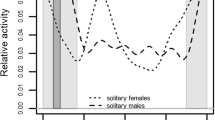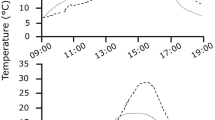Abstract
Wintering birds can gain significant thermal benefits by foraging in direct sunlight. However, exposure to bright sunlight might make birds easier to detect by predators and may also cause visual glare that can reduce a bird’s ability to monitor the environment. Thus, birds likely experience a trade-off between the thermal benefits and predation-related costs of foraging in direct sunlight. To examine this possible thermoregulation-predation trade-off, we monitored the behavior of mixed-species flocks of wintering emberizid sparrows foraging in alternating strips of sunlight and shade. On average, these sparrows routinely preferred to forage in the shade, despite midday air temperatures as much as 30 °C below their thermoneutral zone. This preference for shade was strongest at relatively high temperatures when the thermal benefits of foraging in sunlight were reduced, suggesting a thermoregulation-predation trade-off. Glare could be reduced if birds faced away from the sun while feeding in direct sunlight, but we found that foraging birds tended to face southward (the direction of the sun). We speculate that other factors, such as the likely direction of predator approach, may explain this southerly orientation, particularly if predators use solar glare to their advantage during an attack. This interpretation is supported by the fact that birds had the weakest southerly orientation on cloudy days. Wintering birds may generally avoid foraging in direct sunlight to minimize their risk of predation. However, given the thermal benefits of sunshine, such birds may benefit from foraging in habitats that provide a mosaic of sunlit and shaded microhabitats.




Similar content being viewed by others
References
Bakken GS (1991) Wind speed dependence of the overall thermal conductance of fur and feather insulation. J Therm Biol 16:121–126. doi:10.1016/0306-4565(91)90009-Q
Bakken GS, Murphy MT, Erskine DJ (1991) The effect of wind and air temperature on metabolism and evaporative water loss rates of dark-eyed juncos, Junco hyemalis: a standard operative temperature scale. Physiol Zool 64:1023–1049
Beauchamp G, Ruxton GD (2008) Disentangling risk dilution and collective detection in the antipredator vigilance of semipalmated sandpipers in flocks. Anim Behav 75:1837–1842. doi:10.1016/j.anbehav.2007.12.016
Boysen AF, Lima SL, Bakken GS (2001) Does the thermal environment influence vigilance behavior in dark-eyed juncos (Junco hyemalis)? An approach using standard operative temperature. J Therm Biol 26:605–612. doi:10.1016/S0306-4565(01)00007-9
Carr JM, Lima SL (2012) Heat-conserving postures hinder escape: a thermoregulation-predation trade-off in wintering birds. Behav Ecol 23:434–441. doi:10.1093/beheco/arr208
Carrascal LM, Alonso CL (2006) Habitat use under latent predation risk. A case study with wintering forest birds. Oikos 112:51–62. doi:10.1111/j.0030-1299.2006.13787.x
Carrascal LM, Díaz JA, Huertas DL, Mozetich I (2001) Behavioral thermoregulation by treecreepers: trade-off between saving energy and reducing crypsis. Ecology 82:1642–1654. doi:10.1890/0012-9658(2001).082[1642:BTBTTO]2.0.CO;2
Carrascal LM, Villén-Pérez S, Seoane J (2012) Thermal, food and vegetation effects on winter bird species richness of Mediterranean oakwoods. Ecol Res 27:293–302. doi:10.1007/s11284-011-0900-x
Clark RG, Ohmart RD (1985) Spread-winged posture of turkey vultures: single or multiple function? Condor 87:350–355. doi:10.2307/1367215
Dawson WR, Whittow GC (2000) Regulation of body temperature. In: Whittow GC (ed) Sturkie’s avian physiology, 5th edn. Academic Press, San Diego, pp 343–390
Dolby AS, Grubb TC (1999) Effects of winter weather on horizontal and vertical use of isolated forest fragments by bark-foraging birds. Condor 101:408–412. doi:10.2307/1370006
Fernández-Juricic E, Tran E (2007) Changes in vigilance and foraging behavior with light intensity and their effects on food intake and predator detection in house finches. Anim Behav 74:1381–1390. doi:10.1016/j.anbehav.2007.01.005
Fernández-Juricic E, Erichsen JT, Kacelnik A (2004) Visual perception and social foraging in birds. Trends Ecol Evol 19:25–31. doi:10.1016/j.tree.2003.10.003
Fernández-Juricic E, Deisher M, Stark AC, Randolet J (2012) Predator detection is limited in microhabitats with high light intensity: an experiment with brown-headed cowbirds. Ethology 118:341–350. doi:10.1111/j.1439-0310.2012.02020.x
Fortin D, Larochelle J, Gauthier G (2000) The effect of wind, radiation and body orientation on the thermal environment of Greater Snow goose goslings. J Therm Biol 25:227–238. doi:10.1016/S0306-4565(99)00028-5
Goldstein H, Verbeek NAM, Eisikowitch D, Yom-Tov Y (1987) Sunbirds prefer to feed in the sun. Ardea 75:293–295
Grubb TC (1975) Weather-dependent foraging behavior of some birds wintering in a deciduous woodland. Condor 77:175–182. doi:10.2307/1365788
Hetem RS, Strauss WM, Heusinkveld BG, de Bie S, Prins HHT, van Wieren SE (2011) Energy advantages of orientation to solar radiation in three African ruminants. J Therm Biol 36:452–460. doi:10.1016/j.jtherbio.2011.07.012
Huertas DL, Díaz JA (2001) Winter habitat selection by a montane forest bird assemblage: the effects of solar radiation. Can J Zool 79:279–284. doi:10.1139/cjz-79-2-279
Kacelnik A (1979) Foraging efficiency of great tits (Parus major L.) in relation to light intensity. Anim Behav 27:237–241. doi:10.1016/0003-3472(79)90143-X
Lima SL (1995) Back to the basics of anti-predatory vigilance: the group size effect. Anim Behav 49:11–20. doi:10.1016/0003-3472(95)80149-9
Lima SL, Dill LM (1990) Behavioural decisions made under the risk of predation: a review and prospectus. Can J Zool 68:619–640. doi:10.1139/z90-092
Lustick S, Battersby B, Kelty M (1978) Behavioral thermoregulation: orientation toward the sun in herring gulls. Science 200:81–83
Maloney SK, Moss G, Mitchell D (2005) Orientation to solar radiation in black wildebeest (Connochaetes gnou). J Comp Physiol A 191:1065–1077. doi:10.1007/s00359-005-0031-3
Martin GR, Katzir G (2000) Sun shades and eye size in birds. Brain Behav Evolut 56:340–344. doi:10.1159/000047218
McNamara JM, Houston AI (1990) The value of fat reserves and the trade-off between starvation and predation. Acta Biotheor 38:37–61. doi:10.1007/BF00047272
Meager JJ, Moberg O, Strand E, Utne-Palm AC (2010) Effects of light intensity on visual prey detection by juvenile Atlantic cod (Gadus morhua L.). Mar Freshw Behav Physiol 43:99–108. doi:10.1080/10236241003798910
Ohmart RD, Lasiewski RC (1971) Roadrunners: energy conservation by hypothermia and absorption of sunlight. Science 172:67–69. doi:10.1126/science.172.3978.67
Pettigrew JD (1978) A role for the avian pecten oculi in orientation to the sun? In: Schmidt-Koenig K (ed) Animal migration, navigation and homing. Springer, Berlin, pp 42–54
Pravosudov VV, Grubb TC (1997) Management of fat reserves and food caches in tufted titmice (Parus bicolor) in relation to unpredictable food supply. Behav Ecol 8:332–339. doi:10.1093/beheco/8.3.332
Rice WR (1989) Analyzing tables of statistical tests. Evolution 43:223–225. doi:10.2307/2409177
Richmond HE, Hrabik TR, Mensinger AF (2004) Light intensity, prey detection and foraging mechanisms of age 0 year yellow perch. J Fish Biol 65:195–205. doi:10.1111/j.1095-8649.2004.00444.x
Roth TC, Lima SL (2003) Hunting behavior and diet of Cooper’s Hawks: an urban view of the small-bird-in-winter paradigm. Condor 105:474–483. doi:10.1650/7219
Roth TC, Lima SL, Vetter WE (2006) Determinants of predation risk in small wintering birds: the hawk’s perspective. Behav Ecol Sociobiol 60:195–204. doi:10.1007/s00265-005-0156-y
Tucker VA, Tucker AE, Akers K, Enderson JH (2000) Curved flight paths and sideways vision in peregrine falcons (Falco peregrinus). J Exp Biol 203:3755–3763
Wachob DG (1996) The effect of thermal microclimate on foraging site selection by wintering mountain chickadees. Condor 98:114–122. doi:10.2307/1369514
Walsberg GE (1986) Thermal consequences of roost-site selection: the relative importance of three modes of heat conservation. Auk 103:1–7
Walsberg GE, Tracy RL, Hoffman TCM (1997) Do metabolic responses to solar radiation scale directly with intensity of irradiance? J Exp Biol 200:2115–2121
Webster MD, Weathers WW (1988) Effect of wind and air temperature on metabolic rate in verdins, Auriparus flaviceps. Physiol Zool 61:543–554
Wolf BO, Walsberg GE (1996) Thermal effects of radiation and wind on a small bird and implications for microsite selection. Ecology 77:2228–2236. doi:10.2307/2265716
Wolf BO, Wooden KM, Walsberg GE (2000) Effects of complex radiative and convective environments on the thermal biology of the white-crowned sparrow (Zonotrichia leucophrys gambelii). J Exp Biol 203:803–811
Wood JT, Lustick SI (1989) The effects of artificial solar radiation on wind-stressed tufted titmice (Parus bicolor) and Carolina chickadees (Parus carolinensis) at low temperatures. Comp Biochem Phys A 92:473–477. doi:10.1016/0300-9629(89)90351-4
Acknowledgments
We thank George Bakken for his expert advice and assistance throughout this study. We also thank Luis Carrascal and Sara Villén-Pérez for their helpful comments on the manuscript. The Department of Biology at Indiana State University provided financial assistance for this project. All observations were conducted under an approved Indiana State University Institutional Animal Care and Use Committee protocol (#01-03-2011:SLL/JMC) and comply with the current laws of the United States of America.
Conflict of interest
The authors declare no conflict of interest.
Author information
Authors and Affiliations
Corresponding author
Additional information
Communicated by Chris Whelan.
Rights and permissions
About this article
Cite this article
Carr, J.M., Lima, S.L. Wintering birds avoid warm sunshine: predation and the costs of foraging in sunlight. Oecologia 174, 713–721 (2014). https://doi.org/10.1007/s00442-013-2804-7
Received:
Accepted:
Published:
Issue Date:
DOI: https://doi.org/10.1007/s00442-013-2804-7




